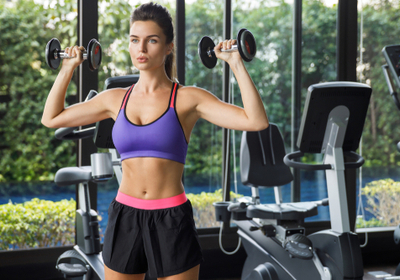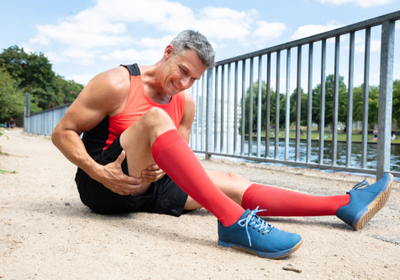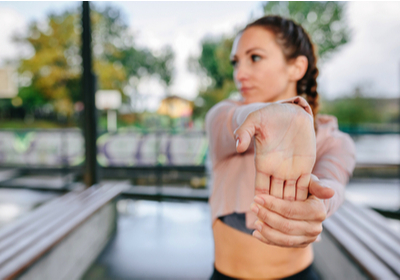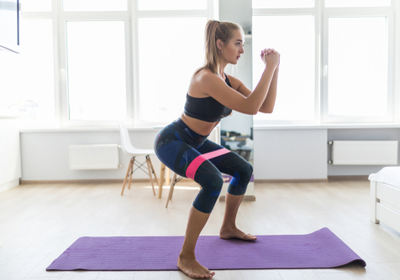VIDEO
Dumbbell Snatch
- Abs
- Wrists
- Biceps
- Triceps
- Upper Back
- Lower Back
- Shoulders
- Gluteus
- Quads
- Hamstrings
- Thighs
- Chest
Level:Advanced
Trainer:Nick Anderson
Equipment:Dumbbell
Dumbbell Snatch
- Abs
- Wrists
- Biceps
- Triceps
- Upper Back
- Lower Back
- Shoulders
- Gluteus
- Quads
- Hamstrings
- Thighs
- Chest
Level:Advanced
Trainer:Nick Anderson
Equipment:Dumbbell
This is a powerful exercise that is going target your lower back, legs, and shoulder stability as well. Stand straight with your feet slightly wider than shoulder-width apart. Squat down, grab the dumbbel in your hand, making sure that your feet are glued to the ground. And keeping your back straight, explode up, lifting the dumbbell above your head. Remember that you need to stay tall, and your back should be straight throughout the movement.
save to ...
RECOMMENDED FOR YOU
Depth Jump to Box Jump
- Gluteus
- Quads
- Hamstrings
Duaration: 00:45
save to playlist
Barbell Front Lunge
- Core
- Gluteus
- Quads
Duaration: 00:50
save to playlist
Sprints
- Core
- Back
- Quads
Duaration: 00:43
save to playlist
Jump Squat Variation, Flutter Kicks, Squats, Alternating Side Lunge
- Core
- Abs
- Quads
Duaration: 00:15
save to playlist
Barbell Thruster
- Core
- Biceps
- Triceps
Duaration: 00:34
save to playlist
Lunge Jump
- Legs
- Gluteus
- Calves
Duaration: 00:24
save to playlist
Deep Squat Variation, Supported Shoulder Stand Variation, Superman Variation, Reverse Plank Forward Leg Lifts
- Core
- Back
- Legs
Duaration: 00:15
save to playlist
Lunge Jumps Variation, Pushups, Step Jumps, Pushup Variation with Jumps, Pushups with Reverse Leg Lifts
- Core
- Arms
- Legs
Duaration: 00:15
save to playlist
Plank Jacks
- Core
- Biceps
- Lower Back
Duaration: 00:39
save to playlist
Pike Up
- Biceps
- Triceps
- Upper Back
Duaration: 00:14
save to playlist
Dumbbell Bulgarian Split Squats
- Upper Back
- Shoulders
- Gluteus
Duaration: 00:47
save to playlist
Barbell Upright Row
- Biceps
- Shoulders
Duaration: 00:39
save to playlist
Dumbbell Goblet Squat
- Upper Back
- Lower Back
- Shoulders
Duaration: 00:36
save to playlist
Plank Crunches, Downward Facing Dog, Vertical Leg Crunches Variation, Double Leg Lifts Variation, Scissors
- Core
- Legs
- Abs
Duaration: 00:15
save to playlist
Dumbbell Side Lunge to Press
- Biceps
- Triceps
- Lower Back
Duaration: 00:44
save to playlist
Single Leg Bench Squat, Bench Jump, Elevated Side Lunge, Step-Up to Reverse Lunge
- Lower Back
- Gluteus
- Quads
Duaration: 00:15
save to playlist
Diamond Knee Pushup
- Biceps
- Triceps
- Chest
Duaration: 00:16
save to playlist
Bridge, Single Leg Bridge, Crunches, Bicycle
- Legs
- Abs
- Lower Back
Duaration: 00:15
save to playlist
Jump Squat Variation, Flutter Kicks, Squats, Alternating Side Lunge
- Biceps
- Trapezius
- Upper Back
Duaration: 00:15
save to playlist
Frog Jumps, Stair Forward Jumps, Twisted Forward Jumps
- Abs
- Gluteus
- Quads
Duaration: 00:14
save to playlist
Squats with Jumps, Side Lunges, Lunges, Standing Forward Leg Lifts, Plank Jumps Variation
- Core
- Legs
- Gluteus
Duaration: 00:15
save to playlist
Plank with Opposite Arm and Leg Lift, Pushups, Elbow Plank Variation, Plank Forward High Knee Lifts
- Core
- Arms
- Legs
Duaration: 00:15
save to playlist
Squat Jump, High Knees, Plank Jumps, Jumping Jacks, Pushups, High Knee Jumps
- Core
- Legs
- Biceps
Duaration: 00:15
save to playlist
Single Leg Box Jump
- Gluteus
- Quads
- Hamstrings
Duaration: 00:39
save to playlist
Step Jumps
- Legs
- Gluteus
- Calves
Duaration: 00:15
save to playlist
Knee Pump
- Abs
- Gluteus
- Quads
Duaration: 00:16
save to playlist
Dumbbell Shrug
- Biceps
- Trapezius
- Upper Back
Duaration: 00:43
save to playlist
Slide and Walk Burpees
- Biceps
- Shoulders
- Gluteus
Duaration: 00:15
save to playlist
Barbell Overhead Squat
- Core
- Biceps
- Upper Back
Duaration: 00:51
save to playlist
Bird Dogs
- Core
- Upper Back
- Shoulders
Duaration: 00:58
save to playlist
Dumbbell Incline Press
- Abs
- Biceps
- Triceps
Duaration: 00:42
save to playlist
Reverse Lunge to High Knee
- Gluteus
- Hamstrings
- Hips
Duaration: 00:20
save to playlist
Handstand Pushup
- Core
- Back
- Legs
Duaration: 00:15
save to playlist
Dumbbell Floor Press
- Biceps
- Upper Back
- Shoulders
Duaration: 00:45
save to playlist
Wall Bridging, High Knee Lifts in Half Handstand
- Core
- Arms
- Legs
Duaration: 00:15
save to playlist
Squat
- Gluteus
- Quads
- Hamstrings
Duaration: 00:29
save to playlist
Kettlebell Single Arm Shrugs
- Trapezius
- Upper Back
- Shoulders
Duaration: 00:38
save to playlist
Reclined Figure Four Stretch
- Gluteus
- Hamstrings
Duaration: 00:20
save to playlist
Shoulder External Rotation
- Biceps
- Triceps
- Shoulders
Duaration: 00:17
save to playlist
Side Lunge, Reverse Lunge, Scissor Legs Elbow Plank, Mountain Climbers, Plank V-Ups
- Core
- Trapezius
- Lower Back
Duaration: 00:15
save to playlist
Blog
A lot of people want to know how to build shoulders at home without dumbbells and other sports equipment at hand. Everything is very simple. Building the muscles of the shoulders, and especially the deltas are easily done with pull-ups and push-ups, which will help to get the shape of your dream.
Workouts for Building Shoulders
Push-upsFor the most part, this exercise will work with the pectoral muscles, but the shoulders will also be involved. A narrow position of the hands will involve the triceps and the middle delta in the work, and if you put your arms wider, then in addition to the middle part, you can also use the front delt muscles. In order to maximize the use of the muscles of the shoulders in the exercise, try to do push-ups a little higher, so that only the deltas work.
One-hand push-upsThis exercise is good for toning the shoulder girdle. It is important to take into account one point: the wider the legs are, the easier it is to perform the exercise, but the less the pressure on the muscles. So choose the best position for yourself.
Dumbbell ShrugsThis exercise is perfect for the shoulders muscles as well as the trapezius muscle. And your posture after doing this exercise regularly will be improved! Stand up keeping your body straight. Hands with dumbbells are lowered. Lift dumbbells, not with your hands, try to include only the shoulders muscles during it, lifting your shoulders as high as possible.
Sideways dumbbellsAlthough the exercise is basic, it is more suitable for athletes with a more advanced level. Doing dumbbells or swinging them is supposed to improve the work of the shoulders. So first of all, you need to stand up slightly leaning forward. In the initial position, the dumbbells are at the bottom. Let’s take a breath and spread them apart, trying to raise them as much as possible. When you get them at shoulder level, pause and gently lower your arms.
Barbell pressIt’s the most effective exercise for building up your shoulders. It is also called a standing barbell press. It is easy to do, firstly you need to put your feet shoulder-width apart, take the barbell with a straight grip and raise it to the chest. After that, you need to exhale and raise the barbell up. After that, you need to stay in this position for a second and slowly lower the barbell to the starting position, while inhaling deeply.
Wrapping Up
In order to quickly build perfect shoulders, you need a nice set of exercises, with which you will achieve maximum results. You can't just exhaust them with working hours in a gym. Follow the advice we gave you and you will get great results as soon as possible.
Read more
The hamstrings are often underestimated. Usually, training focuses on the quads and calves, but the hamstrings seem to be less important. However, it should be remembered that neglecting any muscle has aesthetic and health consequences that you can avoid by working with it well. The reason you shouldn't forget about these muscles isn't just because of the symmetry and the look of your body. A weak hamstring is one of the most common causes of injuries most professional athletes have.
Best Workouts for Hamstrings
The best way to strengthen your hamstrings is, of course, exercising. So let’s talk about these workouts.
Barbell 90The main benefit of this exercise is that you don't need lots of equipment, just a barbell. Start in a standing position with a barbell on your shoulders, keeping your back straight at all times. Bend your knees slightly, stretch your glutes, and bend forward 90 degrees. Then inhale and return back to the starting position. In addition to the hamstrings, this exercise will also strengthen your glutes and back.
HyperextensionHyperextension is a great exercise for the hamstrings, as well as the muscles in the lower back and glutes. Sit comfortably on the hyperextension machine with your heels firmly resting on the platform at the bottom of the machine. Cross your arms over your chest or behind your head. Smoothly lower yourself down until you feel a stretch in the muscles of the lower back and hamstring while inhaling. Without delay at the bottom point, straighten to the level of the starting position, exhaling. Then return to the starting position. Throughout the exercise, keep your head in line with the body, keep your back straight.
Tights upThis exercise can be performed on two horizontal bars on the playground, or simply put your feet on a chair or bench. We will describe the home workout option.
Sit on the floor with your feet on the chair. Raise the body on your hands so that the tights are up in the air. Bend your knees and lift your tights up so that your body is parallel to the floor. Do 7-8 reps.
One foot and dumbbellsThis exercise works well but requires a nice sense of balance. Take dumbbells in your hands, take one leg back and do not lower it to the floor until the end of the exercise. After that get to the previous position. Repeat this exercise a few times until you are tired.
Final Word
Hamstrings might seem insignificant but it doesn’t mean that you can skip working on these muscles. In fact, strong hamstrings will protect you from many injuries. So do not hesitate and start working on these muscles right now.
Read more
While working out most people pay lots of attention to their legs, arms, and abs and quite often they forget about the muscles of their spine, in particular, the lower back. Today, we are going to talk about the health of your lower back as well as how to strengthen these muscles.
Anatomy of Lower Back Muscles
The deep muscles of the back are some of the smallest but strongest muscles that support the spine. Most people mistakenly believe that small is insignificant, but when it comes to these muscles, this is completely wrong. The deep muscles of the back represent a set of muscles that attach to the spine. These muscles are composed of many thick, sinewy bundles that fill the grooves on either side of the spinous processes of the vertebrae and extend from the sacrum to the second cervical vertebra. These muscles spread over 2-4 vertebrae and stabilize the joints at all segmental levels, which allows each vertebra to work more efficiently and reduces the risk of degeneration of the articular structures.
The origin of the deep muscles of the back is the posterior surface of the sacrum, the posterior iliac spines, the mastoid processes of the lumbar vertebrae, and the transverse processes of the thoracic vertebrae. These muscles are attached to the spinous processes of the vertebrae 2-4 segments above the beginning of the muscle.
Exercises for the Lower Back Muscles
In order to keep your lower back strong and healthy, you need to do some simple exercises for this muscle group. So let us take a brief look at those.
Harvesting Apples
Starting in the mountain pose. Raise your hands up and begin to stretch your left hand even higher as if you are trying to reach an apple from a branch above your head. Bend your right knee, pull up your right thigh. Inhale and try to feel the tension in the left square muscle of the lower back. Exhale and relax. Repeat this on the other side. Do 10 repetitions on each side.
Side Stretching
Sit on the floor, resting on your knees, with your hands resting on the floor just below your shoulders. Bring your knees and inner thighs together. Move your hips to the left until you feel comfortable, the left hip is on the bottom, the right is on the top. In this position, look over your right shoulder. Inhale and stretch out along the left lower back and thigh. Exhale, return to the starting position and do the same on the right side. Alternate sides, each time going through the starting position. After doing a few repetitions on each side, you can do the child's pose and rest a little.
Belly Roll
Place a pillow or bolster against your left thigh, then swing your torso towards the pillow. Continuing to stretch in the spine, place your hands on the sides of the pillow and bend over until you touch the pillow with your ribs and chest. Turn your head to the side that is most comfortable for you. Bend your hips and knees until you find a position with a pleasant, light pull on your right side, allowing your right hip to stretch in the opposite direction from your lower ribs. Relax in this position for a few minutes. Then take a few deep breaths and change sides.
Final Word
Developed lower back muscles will help you maintain your back health, which is why you definitely want to work on these muscles. So why don’t you do some of the exercises we mentioned in this article right now?
Read more
Push-ups, exercises with dumbbells, planks, and handstands - all these exercises require strong and flexible wrists and today we will tell you how to develop wrist strength and do exercises without pain and discomfort.
Gymnastics, climbing, crossfit, various martial arts - all these sports require strong wrists. In fact, wrist strength should be developed along with flexibility. This will help you cope with exercises that not only require good grip but also joint mobility. In addition to that, these muscles will allow you to train without pain or injury if you are learning to do a handstand or other challenging elements.
Exercises for the wrists are also useful for people who are not fond of sports. Warming up and stretching these muscles can help avoid tunnel syndrome, which is a compression of the median nerve between the bones and tendons. Warming up will help relieve muscle tension.
Exercises for Wrist Muscles
As you can see, working on your wrists is extremely important for both your health and the ability to do other exercises, which is why you have to know how to correctly develop these muscles. So let’s take a look at some wrist strengthening exercises.
Raising from Wrists to Fists
Sit on the floor with your legs bent under you. Place your hands on the floor on the back of your hand, fingers facing each other. With the strength of your wrists, try to move your hands and make fists. If this works out easily and without pain, transfer your weight to your hands and try again. Reduce the load if pain occurs. Repeat 15 times.
Dumbbell Rows
Place your forearms on a platform. Turn your wrists so that your palms are facing the ceiling. Take the dumbbell with your fingers and start lifting it with the power of your wrist. Start with small weights and gradually increase the load. Perform three sets of 8-10 reps.
Reverse Grip Body Bar Lift
You will need a body bar for this exercise. Unlike the barbell, it is lighter so you can practice without overexertion and pain. Grasp the body bar with a reverse grip, bend your elbows at a 90-degree angle. Open and tilt your palms slightly so that the body bar rolls onto your bent fingers. At the extreme point, the angle at the wrist should be 90 degrees. With the power of your wrist, lift the body bar back up. Perform four sets of 8-10 times.
Holding Dumbbells
Grasp the top of the dumbbells with your fingers. Hold as much as you can - 30 seconds or longer.
Hand Rotation with Dumbbells
Take dumbbells in both hands, bend your elbows at a 90-degree angle. In the starting position, the back of your hands should look up. Flip your hands over so that your fingers are on top, and then return to the starting position. Turning back and forth counts in one go. Perform four sets of 8-10 times.
Wrist Stretching
Sit on your knees, place your palms in front of you, fingers towards you. Pull your torso back, increasing the angle at the wrist. Hold at the extreme point for 3-5 seconds, come back and repeat. Do it 5-10 times.
Wrapping Up
Wrists might seem like insignificant parts of the body, however, you need to develop these muscles to be able to do many exercises. So if you want to improve your wrist muscles, make sure to do these simple workouts and you’ll quickly see the results.
Read more
Everyone wants to have beautiful hips. Unfortunately, it's not that easy to keep it in a nice shape. We have some exercises that will definitely help you work your hips out.
Best Workouts for Hips
Beautiful hips require some effort, so let’s take a look at some exercises for hips.
CrossingsThis deep inner thigh stretch will improve your hips and give you a boost of energy. Spread your legs wide with your feet facing outward. Bend your knees and lower yourself into a squat. Put your hands on your hips just above the knees, deepening the squat and stretching even more. Jump up and place your right foot in front of your left one, while landing, you should straighten and cross your legs. Return to the starting position and repeat the exercise with the other leg. Repeat the exercise, alternating legs, as many times as you can, for at least 40 seconds.
Knee squatsSquats with knees together are much better than regular squats for strengthening the inner thighs, quads, and hamstring. And in order not to waste your time, you can work on your hands at the same time. Stand up straight with your feet together. Take dumbbells, bend your elbows and touch the shoulders with the dumbbells. Do a squat with your knees bent and your hips back as if you were about to sit in a chair. Keep your legs together during the entire exercise. The weight should be on your heels. Now stretch your arms up. Return to the starting position without putting your weight on your toes. Do 10 reps.
Elbow plank with raising legsAdd leg raises to your regular elbow plank to improve the hips. Lie on your side, bend your right arm at the elbow and lean on it. Extend your legs so that your body becomes one straight line. Try to rest only on the outer edge of your right foot. Place your left hand on your thigh. Feel your spine stretch and your abs tighten, then lift your left leg just above your hip. Slowly lower it back down. Do not bend at the waist or lean on your shoulder, keep your weight on your elbow. Do about 15 reps for both sides.
Swings with bent legsThis is one of the most popular exercises for strengthening the buttocks and hips. It is suitable for everyone, does not require additional equipment, and does not involve the spine. With the help of swings, the back, front, outer and inner thighs are worked out - combo. Start in plank, palms - under the shoulders, knees - under the pelvis, keep the position of the back. On the exhale, we swing our leg, pushing the heel up; we perform 20 repetitions on each leg and four sets total.
Side lungesIf you are doing this exercise for the first time, you will not need dumbbells - first master the movements of the legs. Take a dumbbell in your right hand, lunge to the left, lowering your right hand to your right leg. Lower your hips as low as possible, resting on your heels. The toes are facing forward, the angle of the bent leg is 90 degrees. Pushing off with your left foot, go into a courtesy pose: the left leg goes back, and the right one goes forward. Raise your arm with the weight up. Both legs face forward. Keep your hips and legs taut. Repeat without returning to the starting position, but immediately moving from a squat to a side lunge. Do three sets of 10 reps, then switch sides.
Final Word
Beautiful hips are a reality if you know what to do, so why don’t you give these exercises a try and see everything yourself?
Read more
SAVE TO ...





